《金融学》习题二+标准答案
- 格式:doc
- 大小:133.00 KB
- 文档页数:7
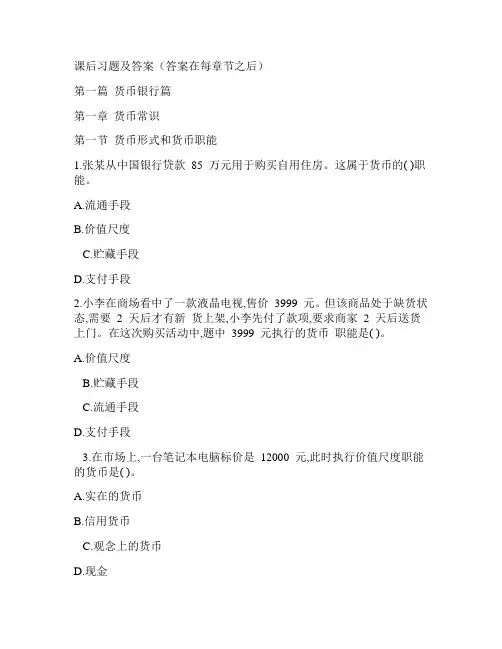
课后习题及答案(答案在每章节之后)第一篇货币银行篇第一章货币常识第一节货币形式和货币职能1.张某从中国银行贷款85 万元用于购买自用住房。
这属于货币的( )职能。
A.流通手段B.价值尺度C.贮藏手段D.支付手段2.小李在商场看中了一款液晶电视,售价3999 元。
但该商品处于缺货状态,需要2 天后才有新货上架,小李先付了款项,要求商家2 天后送货上门。
在这次购买活动中,题中3999 元执行的货币职能是( )。
A.价值尺度B.贮藏手段C.流通手段D.支付手段3.在市场上,一台笔记本电脑标价是12000 元,此时执行价值尺度职能的货币是( )。
A.实在的货币B.信用货币C.观念上的货币D.现金4.商品标价是货币执行价值尺度职能的重要体现,也就是说,商品标价表现着商品的内在价值。
在普通商品中某商品标价为9.98 元,而完全相同的该商品在高档商品的标价为19.98 元。
这表明( )。
(多选)A.标价的差异体现了两家商场产品品质的差异B.货币作为衡量商品价值的尺度有时是不准确的C.商品标价不仅包含商品本身的价值,还包括与买卖商品相关服务的价值D.标价的差异体现了商品价格影响因素的多样性5.下列选项中,属于货币发挥支付手段职能的行为有( )。
(多选)A.税款交纳B.存款或贷款C.工资发放D.赔款支付第二节货币层次划分1.准货币又称亚货币、近似货币,它并不是真正的货币,下列选项中,不属于准货币的是( )。
A.支票B.某单位6 个月定期存款C.股票D.银行承兑汇票2.如果消费者动用储蓄存款进行消费,货币构成将发生的变化是A.M1 减少,M2 增加B.M1 减少,M2 减少C.M2 不变,M1 减少D.M2 不变,M1 增加3.发生以下哪种情形后,M2 的构成仍保持不变?( )A.提高从储蓄账户到支票账户的转账手续费B.各家银行设置了更加多的自动取款机C.其他三项都是D.信用卡被更加广泛地使用4. 根据我国货币层次的划分标准,既属于狭义货币供应量(M1 ),又属于广义货币供应量(M2 )的是( )。
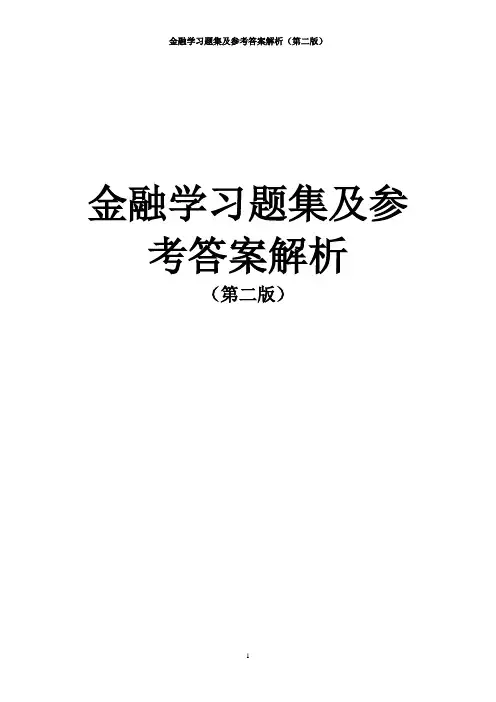
金融学习题集及参考答案解析(第二版)金融学习题集(第二版)带★内容为非金融学专业选做题目第一章货币概述一、单项选择题(在每小题列出的四个备选项中只有一个是最符合题目要求的,请将其代码写在题后的括弧内。
)1.金融的本源性要素是【】A. 货币B. 资金C. 资本D. 市场2.商品价值最原始的表现形式是【】A. 货币价值形式B. 一般价值形式C.总和的或扩大的价值形式D. 简单的或偶然的价值形式3.一切商品的价值共同表现在某一种从商品世界中分离出来而充当一般等价物的商品上时,价值表现形式为【】A. 货币价值形式B. 一般价值形式C.总和的或扩大的价值形式D. 简单的或偶然的价值形式4.价值形式的最高阶段是【】A. 货币价值形式B. 一般价值形式C.总和的或扩大的价值形式D. 简单的或偶然的价值形式5.货币最早的形态是【】A. 实物货币B.代用货币C.信用货币D. 电子货币6.最适宜的实物货币是【】A. 天然贝B. 大理石C. 贵金属D. 硬质合金硬币7.中国最早的货币是【】A. 银圆B. 铜钱C. 金属刀币D. 贝币8.信用货币本身的价值与其货币价值的关系是【】A. 本身价值大于其货币价值B.本身价值等于其货币价值C. 本身价值小于其货币价值D. 无法确定9.在货币层次中M0是指【】A. 投放的现金B. 回笼的现金C. 流通的现金D. 贮藏的现金10.从近期来看,我国货币供给量相含层次指标系列中观察和控制的重点是【】A. M0B. M1C. M2D. M0和M111.从中长期来看,我国货币供给量相含层次指标系列中观察和控制的重点是【】A. M0B. M1C. M2D. M0和M112.货币在表现商品价值并衡量商品价值量的大小时,发挥的职能是【】A. 价值尺度B. 流通手段C. 贮藏手段D. 支付手段13.货币在充当商品流通媒介时发挥的职能是【】A. 价值尺度B. 流通手段C. 贮藏手段D. 支付手段14.当货币退出流通领域,被持有者当作独立的价值形态和社会财富的绝对值化身而保存起来时,货币发挥的职能是【】A. 价值尺度B. 流通手段C. 贮藏手段D. 支付手段15.货币在支付租金、赋税、工资等的时候发挥的职能是【】A. 价值尺度B. 流通手段C. 贮藏手段D. 支付手段16.观念货币可以发挥的职能是【】A. 价值尺度B. 流通手段C. 贮藏手段D. 支付手段17.货币最基本、最重要的职能是【】A. 价值尺度B. 流通手段C. 贮藏手段D. 支付手段18.“劣币驱逐良币现象”产生的货币制度背景是【】A. 银本位B. 平行本位C. 双本位D. 金本位19.最早实行金币本位制的国家是【】A. 美国B. 英国C. 中国D. 德国20.人民币是【】A. 实物货币B. 代用货币C. 金属货币D. 信用货币二、多项选择题(在小题列出的五个备选项中,至少有二个是符合题目要求的,请将其代码写在题后的括弧内。
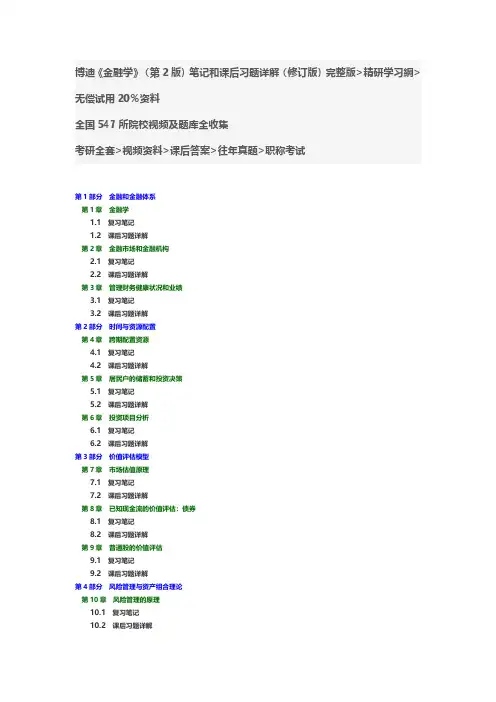
博迪《金融学》(第2版)笔记和课后习题详解(修订版)完整版>精研学习䋞>无偿试用20%资料全国547所院校视频及题库全收集考研全套>视频资料>课后答案>往年真题>职称考试第1部分金融和金融体系第1章金融学1.1复习笔记1.2课后习题详解第2章金融市场和金融机构2.1复习笔记2.2课后习题详解第3章管理财务健康状况和业绩3.1复习笔记3.2课后习题详解第2部分时间与资源配置第4章跨期配置资源4.1复习笔记4.2课后习题详解第5章居民户的储蓄和投资决策5.1复习笔记5.2课后习题详解第6章投资项目分析6.1复习笔记6.2课后习题详解第3部分价值评估模型第7章市场估值原理7.1复习笔记7.2课后习题详解第8章已知现金流的价值评估:债券8.1复习笔记8.2课后习题详解第9章普通股的价值评估9.1复习笔记9.2课后习题详解第4部分风险管理与资产组合理论第10章风险管理的原理10.1复习笔记10.2课后习题详解第11章对冲、投保和分散化11.1复习笔记11.2课后习题详解第12章资产组合机会和选择12.1复习笔记12.2课后习题详解第5部分资产定价第13章资本市场均衡13.1复习笔记13.2课后习题详解第14章远期市场与期货市场14.1复习笔记14.2课后习题详解第15章期权市场与或有索取权市场15.1复习笔记15.2课后习题详解第6部分公司金融第16章企业的财务结构16.1复习笔记16.2课后习题详解第17章实物期权17.1复习笔记17.2课后习题详解。
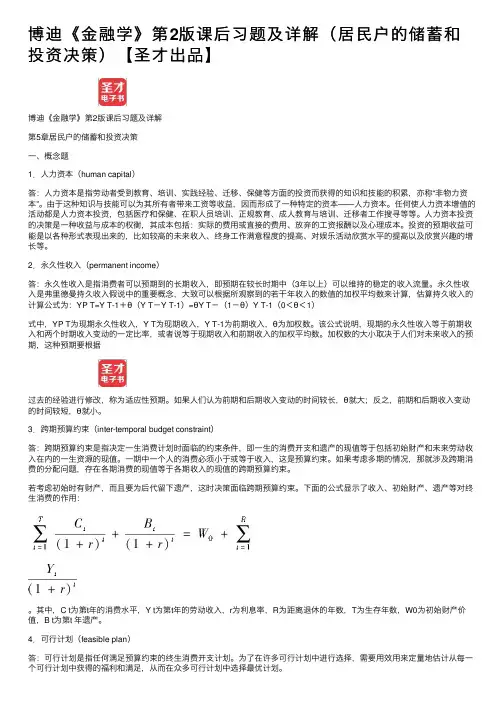
博迪《⾦融学》第2版课后习题及详解(居民户的储蓄和投资决策)【圣才出品】博迪《⾦融学》第2版课后习题及详解第5章居民户的储蓄和投资决策⼀、概念题1.⼈⼒资本(human capital)答:⼈⼒资本是指劳动者受到教育、培训、实践经验、迁移、保健等⽅⾯的投资⽽获得的知识和技能的积累,亦称“⾮物⼒资本”。
由于这种知识与技能可以为其所有者带来⼯资等收益,因⽽形成了⼀种特定的资本——⼈⼒资本。
任何使⼈⼒资本增值的活动都是⼈⼒资本投资,包括医疗和保健、在职⼈员培训、正规教育、成⼈教育与培训、迁移者⼯作搜寻等等。
⼈⼒资本投资的决策是⼀种收益与成本的权衡,其成本包括:实际的费⽤或直接的费⽤、放弃的⼯资报酬以及⼼理成本。
投资的预期收益可能是以各种形式表现出来的,⽐如较⾼的未来收⼊、终⾝⼯作满意程度的提⾼、对娱乐活动欣赏⽔平的提⾼以及欣赏兴趣的增长等。
2.永久性收⼊(permanent income)答:永久性收⼊是指消费者可以预期到的长期收⼊,即预期在较长时期中(3年以上)可以维持的稳定的收⼊流量。
永久性收⼊是弗⾥德曼持久收⼊假说中的重要概念,⼤致可以根据所观察到的若⼲年收⼊的数值的加权平均数来计算,估算持久收⼊的计算公式为:YP T=Y T-1+θ(Y T-Y T-1)=θY T-(1-θ)Y T-1(0<θ<1)式中,YP T为现期永久性收⼊,Y T为现期收⼊,Y T-1为前期收⼊,θ为加权数。
该公式说明,现期的永久性收⼊等于前期收⼊和两个时期收⼊变动的⼀定⽐率,或者说等于现期收⼊和前期收⼊的加权平均数。
加权数的⼤⼩取决于⼈们对未来收⼊的预期,这种预期要根据过去的经验进⾏修改,称为适应性预期。
如果⼈们认为前期和后期收⼊变动的时间较长,θ就⼤;反之,前期和后期收⼊变动的时间较短,θ就⼩。
3.跨期预算约束(inter-temporal budget constraint)答:跨期预算约束是指决定⼀⽣消费计划时⾯临的约束条件,即⼀⽣的消费开⽀和遗产的现值等于包括初始财产和未来劳动收⼊在内的⼀⽣资源的现值。
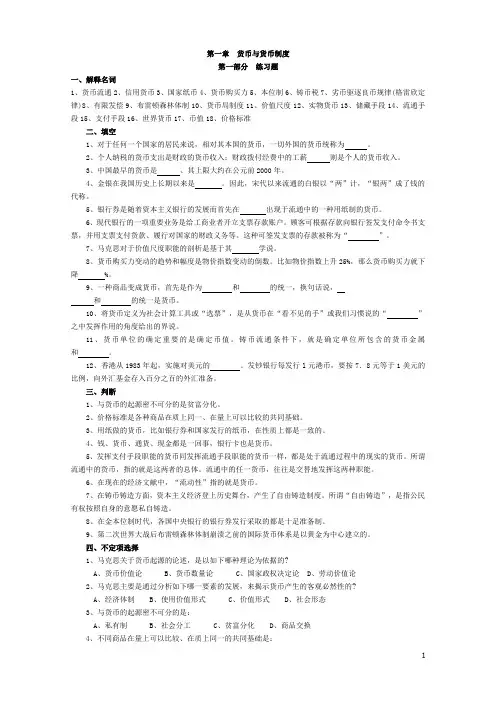
第一章货币与货币制度第一部分练习题一、解释名词1、货币流通2、信用货币3、国家纸币4、货币购买力5、本位制6、铸币税7、劣币驱逐良币规律(格雷欣定律)8、有限发偿9、布雷顿森林体制10、货币局制度11、价值尺度12、实物货币13、储藏手段14、流通手段15、支付手段16、世界货币17、币值18、价格标准二、填空1、对于任何一个国家的居民来说,相对其本国的货币,一切外国的货币统称为。
2、个人纳税的货币支出是财政的货币收入;财政拨付经费中的工薪则是个人的货币收入。
3、中国最早的货币是、其上限大约在公元前2000年。
4、金银在我国历史上长期以来是。
因此,宋代以来流通的白银以“两”计,“银两”成了钱的代称。
5、银行券是随着资本主义银行的发展而首先在出现于流通中的一种用纸制的货币。
6、现代银行的一项重要业务是给工商业者开立支票存款账户。
顾客可根据存款向银行签发支付命令书支票,并用支票支付货款、履行对国家的财政义务等。
这种可签发支票的存款被称为“”。
7、马克思对于价值尺度职能的剖析是基于其学说。
8、货币购买力变动的趋势和幅度是物价指数变动的倒数。
比如物价指数上升25%,那么货币购买力就下降 %。
9、一种商品变成货币,首先是作为和的统一,换句话说,和的统一是货币。
10、将货币定义为社会计算工具或“选票”,是从货币在“看不见的手”或我们习惯说的“”之中发挥作用的角度给出的界说。
11、货币单位的确定重要的是确定币值。
铸币流通条件下,就是确定单位所包含的货币金属和。
12、香港从1983年起,实施对美元的。
发钞银行每发行l元港币,要按7.8元等于1美元的比例,向外汇基金存入百分之百的外汇准备。
三、判断1、与货币的起源密不可分的是贫富分化。
2、价格标准是各种商品在质上同一、在量上可以比较的共同基础。
3、用纸做的货币,比如银行券和国家发行的纸币,在性质上都是一致的。
4、钱、货币、通货、现金都是一回事,银行卡也是货币。
5、发挥支付手段职能的货币同发挥流通手段职能的货币一样,都是处于流通过程中的现实的货币。

《⾦融学(第⼆版)》讲义⼤纲及课后习题答案详解⼗⼆章CHAPTER 12CHOOSING AN INVESTMENT PORTFOLIOObjectivesTo understand the process of personal investing in theory and in practice.To build a quantitative model of the tradeoff between risk and reward.Outline12.1 The Process of Personal Portfolio Selection12.2 The Trade-off between Expected Return and Risk12.3 Efficient Diversification with Many Risky AssetsSummaryThere is no single portfolio selection strategy that is best for all people.Stage in the life cycle is an imp ortant determinant of the optimal composition of a person’s optimal portfolio of assets and liabilities.Time horizons are important in portfolio selection. We distinguish among three time horizons: the planning horizon, the decision horizon, and the trading horizon.In making portfolio selection decisions, people can in general achieve a higher expected rate of return only by exposing themselves to greater risk.One can sometimes reduce risk without lowering expected return by diversifying more completely either withina given asset class or across asset classes.The power of diversification to reduce the riskiness of an investor’s portfolio depends on the correlations among the assets that make up the portfolio. In practice, the vast majority of assets are positively correlated with each other because they are all affected by common economic factors. Consequently, one’s ability to reduce risk through diversification among risky assets without lowering expected return is limited.Although in principle people have thousands of assets to choose from, in practice they make their choices from a menu of a few final products offered by financial intermediaries such as bank accounts, stock and bond mutual funds, and real estate. In designing and producing the menu of assets to offer to their customers theseintermediaries make use of the latest advances in financial technology.Solutions to Problems at End of Chapter1. Suppose that your 58-year-old father works for the Ruffy Stuffed Toy Company and has contributed regularly to his company-matched savings plan for the past 15 years. Ruffy contributes $0.50 for every $1.00 your father puts into the savings plan, up to the first 6% of his salary. Participants in the savings plan can allocate their contributions among four different investment choices: a fixed-income bond fund, a “blend” option that invests in large companies, small companies, and the fixed-income bond fund, a growth-income mutual fund whose investments do not include other toy companies, and a fund whose sole investment is stock in the Ruffy Stuffed Toy Company. Over Thanksgiving vacation, Dad realizes that you have been majoring in finance and decides to reap some early returns on that tuition money he’s been investing in your education. He shows you the most recent quarterly statement for his savings plan, and you see that 98% of its current value is in the fourth investment option, that of the Ruffy Company stock..a.Assume that your Dad is a typical risk-averse person who is considering retirement in five years. Whenyou ask him why he has made the allocation in this way, he responds that the company stock has continually performed quite well, except for a few declines that were caused by problems in a division that the company has long since sold off. Inaddition, he says, many of his friends at work have done the same. What advice would you give your dad about adjustments to his plan allocations? Why?b.If you consider the fact that your dad works for Ruffy in addition to his 98% allocation to the Ruffy stockfund, does this make his situation more risky, less risky, or does it make no difference? Why? SOLUTION:a.Dad has exposed himself to risk by concentrating almost all of his plan money in the Ruffy Stock fund. This is analogous to taking 100% of the money a family has put aside for investment and investing it in a single stock.First, Dad needs to be shown that just because the company stock has continually performed quite well is no guarantee that it will do so indefinitely. The company may have sold off the divisions which produced price declines in the past, but future problems are unpredictable, and so is the movement of the stock price. “Past performance is no guarantee of future results” is the lesson.Second, Dad needs to hear about diversification. He needs to be counseled that he can reduce his risk by allocating his money among several of the options available to him. Indeed, he can reduce his risk considerably merely by moving all of his money into the “blend” fund because it is diversifi ed by design: it has a fixed-income component, a large companies component, and a small companies component. Diversification isachieved not only via the three differing objectives of these components, but also via the numerous stocks that comprise each of the three components.Finally, Dad’s age and his retirement plans need to be considered. People nearing retirement age typically begin to shift the value of their portfolios into safer investments. “Safer” normally connotes less variability, so that the risk of a large decline in the value of a portfolio is reduced. This decline could come at any time, and it would be very unfortunate if it were to happen the day before Dad retires. In this example, the safest option would be the fixed-income bond fund because of its diversified composition and interest-bearing design, but there is still risk exposure to inflation and the level of interest rates. Note that the tax-deferred nature of the savings plan encourages allocation to something that produces interest or dividends. As it stands now, Dad is very exposed to a large decline in the value of his savings plan because it is dependent on the value of one stock.Individual equities over time have proven to produce the most variable of returns, so Dad should definitely move some, probably at least half, of his money out of the Ruffy stock fund. In fact, a good recommendation given his retirement horizon of five years would be to re-align the portfolio so that it has 50% in the fixed- income fund and the remaining 50% split between the Ruffy stock fund (since Dad insists) and the “blend” fund.Or, maybe 40% fixed-income, 25% Ruffy, 15% growth-income fund, and 20% “blend” fund. This latterallocation has the advantage of introducing another income-producing component that can be shielded by the tax-deferred status of the plan.b.The fact that Dad is employed by the Ruffy Company makes his situation more risky. Let’s say that the companyhits a period of slowed business activities. If the stock price declines, so will th e value of Dad’s savings plan. If the company encounters enough trouble, it may consider layoffs. Dad’s job may be in jeopardy. At the same time that his savings plan may be declining in value, Dad may also need to look for a job or go onunemployment. Thus, Dad is exposed on two fronts to the same risk. He has invested both his human capital and his wealth almost exclusively in one company.2. Refer to Table 12.1.a.Perform the calculations to verify that the expected returns of each of the portfolios (F, G, H, J, S) in thetable (column 4) are correct.b.Do the same for the standard deviations in column 5 of the table.c.Assume that you have $1million to invest. Allocate the money as indicated in the table for each of the fiveportfolios and calculate the expected dollar return of each of the portfolios.d.Which of the portfolios would someone who is extremely risk tolerant be most likely to select? SOLUTION:d.An extremely risk tolerant person would select portfolio S, which has the largest standard deviation but also thelargest expected return.3. A mutual fund company offers a safe money market fund whose current rate is4.50% (.045). The same company also offers an equity fund with an aggressive growth objective which historically has exhibited an expected return of 20% (.20) and a standard deviation of .25.a.Derive the equation for the risk-reward trade-off line.b.How much extra expected return would be available to an investor for each unit of extra risk that shebears?c.What allocation should be placed in the money market fund if an investor desires an expected return of15% (.15)?SOLUTION:a.E[r] = .045 + .62b.0.62c.32.3% [.15 = w*(.045) + (1-w)*(.020) ]4. If the risk-reward trade-off line for a riskless asset and a risky asset results in a negative slope, what does that imply about the risky asset vis-a-vis the riskless asset?SOLUTION:A trade-off line wit h a negative slope indicates that the investor is “rewarded” with less expected return for taking on additional risk via allocation to the risky asset.5. Suppose that you have the opportunity to buy stock in AT&T and Microsoft.a.stocks is 0? .5? 1? -1? What do you notice about the change in the allocations between AT&T andMicrosoft as their correlation moves from -1 to 0? to .5? to +1? Why might this be?b.What is the variance of each of the minimum-variance portfolios in part a?c.What is the optimal combination of these two securities in a portfolio for each value of the correlation,assuming the existence of a money market fund that currently pays 4.5% (.045)? Do you notice any relation between these weights and the weights for the minimum variance portfolios?d.What is the variance of each of the optimal portfolios?e.What is the expected return of each of the optimal portfolios?f.Derive the risk-reward trade-off line for the optimal portfolio when the correlation is .5. How much extraexpected return can you anticipate if you take on an extra unit of risk?SOLUTION:a.Minimum risk portfolios if correlation is:-1: 62.5% AT&T, 37.5% Microsoft0: 73.5% AT&T, 26.5% Microsoft.5: 92.1% AT&T, 7.9% Microsoft1: 250% AT&T, short sell 150% MicrosoftAs the correlation moves from -1 to +1, the allocation to AT&T increases. When two stocks have negativec orrelation, standard deviation can be reduced dramatically by mixing them in a portfolio. It is to the investors’benefit to weight more heavily the stock with the higher expected return since this will produce a high portfolio expected return while the standard deviation of the portfolio is decreased. This is why the highest allocation to Microsoft is observed for a correlation of -1, and the allocation to Microsoft decreases as the correlationbecomes positive and moves to +1. With correlation of +1, the returns of the two stocks will move closely together, so you want to weight most heavily the stock with the lower individual standard deviation.b. Variances of each of the minimum variance portfolios:62.5% AT&T, 37.5% Microsoft Var = 073.5% AT&T, 26.5% Microsoft Var = .016592.1% AT&T, 7.9% Microsoft Var = .0222250% AT&T, short 150% Microsoft Var = 0c. Optimal portfolios if correlation is:-1: 62.5% AT&T, 37.5% Microsoft0: 48.1% AT&T, 51.9% Microsoft.5: 11.4% AT&T, 88.6% Microsoft1: 250% AT&T, short 150% Microsoftd. Variances of the optimal portfolios:62.5% AT&T, 37.5% Microsoft Var = 048.1% AT&T, 51.9% Microsoft Var = .022011.4% AT&T, 88.6% Microsoft Var = .0531250% AT&T, short 150% Microsoft Var = 0e. Expected returns of the optimal portfolios:62.5% AT&T, 37.5% Microsoft E[r] = 14.13%48.1% AT&T, 51.9% Microsoft E[r] = 15.71%11.4% AT&T, 88.6% Microsoft E[r] = 19.75%250% AT&T, short 150% Microsoft E[r] = -6.5%f.Risk-reward trade-off line for optimal portfolio with correlation = .5:E[r] = .045 + .66/doc/31dbf23b580216fc700afd59.html ing the optimal portfolio of AT&T and Microsoft stock when the correlation of their price movements is 0.5, along with the results in part f of question 12-5, determine:a.the expected return and standard deviation of a portfolio which invests 100% in a money market fundreturning a current rate of 4.5%. Where is this point on the risk-reward trade-off line?b.the expected return and standard deviation of a portfolio which invests 90% in the money market fundand 10% in the portfolio of AT&T and Microsoft stock.c.the expected return and standard deviation of a portfolio which invests 25% in the money market fundand 75% in the portfolio of AT&T and Microsoft stock.d.the expected return and standard deviation of a portfolio which invests 0% in the money market fundand 100% in the portfolio of AT&T and Microsoft stock. What point is this?SOLUTION:a.E[r] = 4.5%, standard deviation = 0. This point is the intercept of the y (expected return) axis by the risk-rewardtrade-off line.b.E[r] = 6.03%, standard deviation = .0231c.E[r] = 15.9%, standard deviation = .173d.E[r] = 19.75%, standard deviation = .2306. This point is the tangency between the risk-reward line from 12-5part f and the risky asset risk-reward curve (frontier) for AT&T and Microsoft.7. Again using the optimal portfolio of AT&T and Microsoft stock when the correlation of their price movements is 0.5, take $ 10,000 and determine the allocations among the riskless asset, AT&T stock, and Microsoft stock for:a. a portfolio which invests 75% in a money market fund and 25% in the portfolio of AT&T and Microsoftstock. What is this portfolio’s expected return?b. a portfolio which invests 25% in a money market fund and 75% in the portfolio of AT&T and Microsoftstock. What is this portfolio’s expect ed return?c. a portfolio which invests nothing in a money market fund and 100% in the portfolio of AT&T andMicrosoft stock. What is this portfolio’s expected return?SOLUTION:a.$7,500 in the money-market fund, $285 in AT&T (11.4% of $2500), $2215 in Microsoft. E[r] = 8.31%, $831.b.$2,500 in the money-market fund, $855 in AT&T (11.4% of $7500), $6645 in Microsoft. E[r] = 15.94%, $1,594.c.$1140 in AT&T, $8860 in Microsoft. E[r] = 19.75%, $1,975.8. What strategy is implied by moving further out to the right on a risk-reward trade-off line beyond the tangency point between the line and the risky asset risk-reward curve? What type of an investor would be most likely to embark on this strategy? Why?SOLUTION:This strategy calls for borrowing additional funds and investing them in the optimal portfolio of AT&T and Microsoft stock. A risk-tolerant, aggressive investor would embark on this strategy. This person would be assuming the risk of the stock portfolio with no risk-free component; the money at risk is not onl y from this person’s own wealth but also represents a sum that isowed to some creditor (such as a margin account extended by the investor’s broker).9. Determine the correlation between price movements of stock A and B using the forecasts of their rate of return and the assessments of the possible states of the world in the following table. The standard deviations for stock A and stock B are0.065 and 0.1392, respectively. Before doing the calculation, form an expectation of whether that correlation will be closer to1 or -1 by merely inspecting the numbers.SOLUTION:Expectation: correlation will be closer to +1.E[r A] = .05*(-.02) + .15*(-.01) + .60*(.15) + .20*(.15) = .1175, or, 11.75%E[r B] = .05*(-.20) + .15*(-.10) + .60*(.15) + .20*(.30) = .1250, or, 12.50%Covariance = .05*(-.02-.1175)*(-.20-.125) + .15*(-.01-.1175)*(-.10-.125) +.60*(.15-.1175)*(.15-.125) + .20*(.15-.1175)*(.30-.125) =.008163Correlation = .008163/(.065)*(.1392) = .90210.Analyze the “expert’s” answers to the following questions:a.Question:I have approx. 1/3 of my investments in stocks, and the rest in a money market. What do you suggestas a somewhat “safer” place to invest another 1/3? I like to keep 1/3 accessible for emergencies.Expert’s answer:Well, you could try 1 or 2 year Treasury bonds. You’d get a little bit more yie ld with no risk.b.Question:Where would you invest if you were to start today?Expert’s answer:That depends on your age and short-term goals. If you are very young – say under 40 –and don’tneed the money you’re investing for a home or college tuition or such, you would put it in a stockfund. Even if the market tanks, you have time to recoup. And, so far, nothing has beaten stocks overa period of 10 years or more. But if you are going to need money fairly soon, for a home or for yourretirement, you need to play it safer.SOLUTION:a.You are not getting a little bit more yield with no risk. The real value of the bond payoff is subject to inflationrisk. In addition, if you ever need to sell the Treasury bonds before expiration, you are subject to the fluctuation of selling price caused by interest risk.b.The expert is right in pointing out that your investment decision depends on your age and short-term goals. In addition, the investment decision also depends on other characteristics of the investor, such as the special character of the labor income (whether it is highly correlated with the stock market or not), and risk tolerance.Also, the fact that over any period of 10 years or more the stock beats everything else cannot be used to predict the future.。
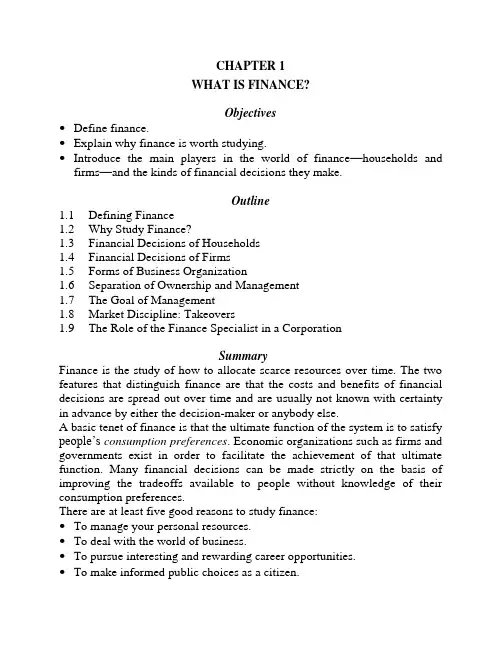
CHAPTER 1WHAT IS FINANCE?Objectives∙Define finance.∙Explain why finance is worth studying.∙Introduce the main players in the world of finance—households and firms—and the kinds of financial decisions they make.Outline1.1 Defining Finance1.2 Why Study Finance?1.3 Financial Decisions of Households1.4 Financial Decisions of Firms1.5 Forms of Business Organization1.6 Separation of Ownership and Management1.7 The Goal of Management1.8 Market Discipline: Takeovers1.9 The Role of the Finance Specialist in a CorporationSummaryFinance is the study of how to allocate scarce resources over time. The two features that distinguish finance are that the costs and benefits of financial decisions are spread out over time and are usually not known with certainty in advance by either the decision-maker or anybody else.A basic tenet of finance is that the ultimate function of the system is to satisfy people’s consumption preferences. Economic organizations such as firms and governments exist in order to facilitate the achievement of that ultimate function. Many financial decisions can be made strictly on the basis of improving the tradeoffs available to people without knowledge of their consumption preferences.There are at least five good reasons to study finance:∙To manage your personal resources.∙To deal with the world of business.∙To pursue interesting and rewarding career opportunities.∙To make informed public choices as a citizen.∙To expand your mind.The players in finance theory are households and business firms. Households occupy a special place in the theory because the ultimate function of the system is to satisfy the preferences of people, and the theory treats those preferences as given. Finance theory explains household behavior as an attempt to satisfy those preferences. The behavior of firms is viewed from the perspective of how it affects the welfare of households.Households face four basic types of financial decisions:∙Saving decisions: How much of their current income should they save for the future?∙Investment decisions: How should they invest the money they have saved? ∙Financing decisions: When and how should they use other people’s money to satisfy their wants and needs?∙Risk management decisions: How and on what terms should they seek to reduce the economic uncertainties they face or to take calculated risks?There are three main areas of financial decision-making in a business: capital budgeting, capital structure, and working capital management.There are five reasons for separating the management from the ownership of a business enterprise:∙Professional managers may be found who have a superior ability to run the business.∙To achieve the efficient scale of a business the resources of many households may have to be pooled.∙In an uncertain economic environment, owners will want to diversify their risks across many firms. Such efficient diversification is difficult to achieve without separation of ownership and management.∙Savings in the costs of gathering information.∙The “learning curve” or “going concern” effect. When the owner is also the manager, the new owner has to learn the business from the old owner in order to manage it efficiently. If the owner is not the manager, then when the business is sold, the manager continues in place and works for the new owner.The corporate form is especially well suited to the separation of ownership and management of firms because it allows relatively frequent changes in owners by share transfer without affecting the operations of the firm.The primary goal of corporate management is to maximize shareholder wealth. It leads managers to make the same investment decisions that each of the individual owners would have made had they made the decisions themselves.A competitive stock market imposes a strong discipline on managers to take actions to maximize the market value of the firm’s shares.Solutions to Problems at End of Chapter1. What are your main goals in life? How does finance play a part in achieving those goals? What are the major trade-offs you face? SAMPLE ANSWER:∙Finish school∙Get good paying job which I like∙Get married and have children∙Own my own home∙Provide for family∙Pay for children’s education∙RetireHow Finance Plays a Role:SAMPLE ANSWER:∙Finance helps me pay for undergraduate and graduate education and helps me decide whether spending the money on graduate education will be a good investment decision or not.∙Higher education should enhance my earning power and ability to obtain a job I like.∙Once I am married and have children I will have additional financial responsibilities (dependents) and I will have to learn how to allocate resources among individuals in the household and learn how to set aside enough money to pay for emergencies, education, vacations etc. Finance also helps me understand how to manage risks such as for disability, life and health.∙Finance helps me determine whether the home I want to buy is a good value or not. The study of finance also helps me determine the cheapest source of financing for the purchase of that home.∙Finance helps me determine how much money I will have to save in order to pay for my children’s education as well as my own retirement.Major Trade-Offs:SAMPLE ANSWER∙Spend money now by going to college (and possibly graduate school) but presumably make more money once I graduate due to my higher education.∙Consume now and have less money saved for future expenditures such as for a house or car OR save more money now but consume less than some of my friends.2. What is your net worth? What have you included among your assets and your liabilities? What have you excluded that you might have included?SAMPLE ANSWER:$ ____________ (very possibly negative at this point)Assets:∙Checking account balance∙Savings account balance∙Furniture/Jewelry (watch)∙Car (possibly)Liabilities:∙Student loans∙Credit card balance∙If renting, remainder of rental agreement (unless subletting is a possibility) ∙Car payments (possibly)Students typically exclude the high value of their potential lifetime earning power when calculating their net worth.3. How are the financial decisions faced by a single person living alone different from those faced by the head of a household with responsibility for several children of school age? Are the tradeoffs they have to make different, or will they evaluate the tradeoffs differently?A single person needs only to support himself and therefore can make every financial decision on his own. If he does not want health insurance (and is willing to bear the financial risks associated with that decision) then no one will be affected by that decision other than that single person. In addition, this person needs to make no decisions about allocating income among dependents. A single person is very mobile and can choose to live almost anywhere. The tradeoffs this individual makes generally concern issues of consuming (or spending) today versus saving for consumption tomorrow. Since this person is supporting only himself, the need to save now is less important than for the head of household discussed next.The head of household with several children must share resources (income) among dependents. This individual must be prepared to deal with risk management issues such as how to be prepared for potential financial emergencies (such as a serious health problem experienced by a member of the family or home owners insurance in case of a fire or other mishap). Because there are more people in this household than with a single person, there are greater risks that someone will get sick or injured. And because there are dependents, the wage earner(s) should think carefully about life and disability insurance. In addition, the family is not as mobile as the single individual. Because of the school age children, the family might want to live near “good schools” thinking that a stronger education will eventually help those children’s future well being and financial situation. Thus, the tradeoffs for the head of household are more complex: more money is needed to consume today (he or she needs to support more dependents), but a lot more money is also needed to save for future expenses such as education and housing and more money is needed for risk management such as life and disability insurance.4. Family A and family B both consist of a father, mother and two children of school age. In family A both spouses have jobs outside the home and earn a combined income of $100,000 per year. In family B, only one spouse works outside the home and earns $100,000 per year.How do the financial circumstances and decisions faced by the two families differ?With two wage earners, there is less risk of a total loss of family income due to unemployment or disability than there is in a single wage earning household. The single wage earning family will probably want more disability and life insurance than the two wage earning family. On the flip side, however, the two wage earning family may need to spend extra money on child care expenses if they need to pay someone to watch the children after school.5. At what age should children be expected to become financially independent?Students will have differing responses to this question depending upon their specific experiences and opinions. Most will probably say independence should come after finishing their education, and they have a decent paying job.6. You are thinking of buying a car. Analyze the decision by addressing the following issues:a.Are there other ways to satisfy your transportation requirementsbesides buying a car? Make a list of all the alternatives and write down the pros and cons.b.What are the different ways you can finance the purchase of a car? Finance through a bank loan or lease, finance through a car dealer with a loan or a lease or finance the car out of your own savings.c.Obtain information from at least three different providers ofautomobile financing on the terms they offer.d.What criteria should you use in making your decision?Your decision will be to select the financing alternative that has the lowest cost to you.When analyzing the information, you should consider the following:∙Do you have the cash saved to make an outright purchase? What interest rate would you be giving up to make that purchase? Do you pay a different price for the car if you pay cash rather than finance?∙For differing loan plans, what is the down payment today? What are the monthly payments? For how long? What is the relevant interest rate you will be paying? Does the whole loan get paid through monthly payments or is there a balloon payment at the end? Are taxes and/or insurance payments included in the monthly payments?∙For differing lease plans, what is the down payment today? What are the monthly payments? For how long? Do you own the car at the end of the lease? If not, what does it cost to buy the car? Do you have to buy the car at the end of the lease or is it an option? Is there a charge if you decide not to buy the car? What relevant interest rate will you be paying? Are taxes and/or insurance payments included in the monthly payments? Are there mileage restrictions?7. You are thinking of starting your own business, but have no money.a.Think of a business that you could start without having to borrow anymoney.Any business which involves a student’s own personal service would be cheap to start up. For instance he or she could start a business running errands for others, walking their dogs, shopping etc. Along those same lines they could start some kind of consulting business. Both of these businesses could be run out of their dorm room or their own home and could be started with very little capital. If they wanted to hire additional workers, they would have to be paid on a commission basis to limit upfront expenses.b.Now think of a business that you would want to start if you couldborrow any amount of money at the going market interest rate. Certainly there are many interesting businesses which could be started if one could finance 100% of the business with borrowed capital and no equity. Since you will be able to borrow 100% of the financing, you will be willing to take a lot greater risk than if you were investing your own money.c.What are the risks you would face in this business?[Answer is, of course, dependent on answer to question “b.”]d.Where can you get financing for your new business?Depending upon the size of the financing needed, students should be looking for both debt and equity financing. The sources of this financing ranges from individuals and credit cards (for very small sums) to banks, venture capitalists, public debt and equity markets, insurance companies and pension funds8. Choose an organization that is not a firm, such as a club or church group and list the most important financial decisions it has to make. What are the key tradeoffs the organization faces? What role do preferences play in choosing among alternatives? Interview the financial manager of the organization and check to see if he or she agrees with you. SAMPLE ANSWER:Local Church group. Most important financial decisions:∙Whether or not to repair damage done to church and grounds during last big hurricane (specifically repairing the leaking roof)∙What project to put off in order to pay for repair damage∙How to pay for renovations to downstairs Sunday school rooms∙How to increase member attendance and contributions∙How to organize and solicit volunteers for the annual Church Sale (largest fund raiser of the year)Key Tradeoffs and Preferences:Church group funds are severely limited, so the organization needs to prioritize expenses based upon cost and need. Not all projects that are needed will be undertaken due to the expense involved. An equally large amount of time will be spent trying to raise financing since funds inflow is variable. Since not all projects can be financed, preferences of differentFinance Instructor’s Manual Chapter 1Page 27 important individuals (such as the pastor) take on great significance in the decision-making process.。
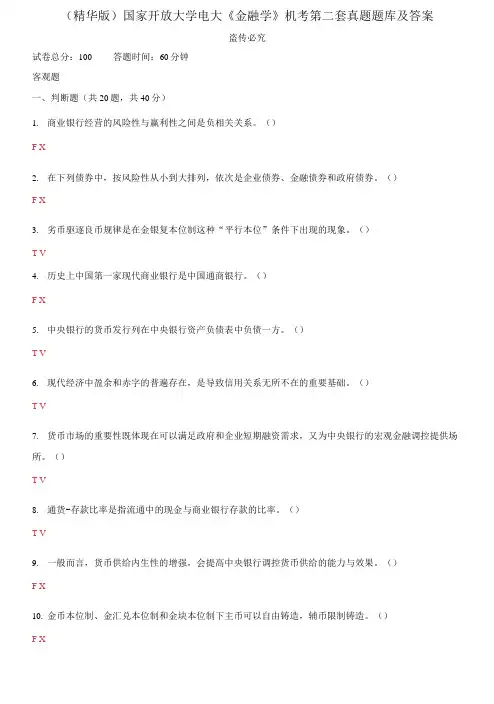
(精华版)国家开放大学电大《金融学》机考第二套真题题库及答案盗传必究试卷总分:100 答题时间:60分钟客观题一、判断题(共20题,共40分)1.商业银行经营的风险性与赢利性之间是负相关关系。
()F X2.在下列债券中,按风险性从小到大排列,依次是企业债券、金融债券和政府债券。
()F X3.劣币驱逐良币规律是在金银复本位制这种“平行本位”条件下出现的现象。
()T V4.历史上中国第一家现代商业银行是中国通商银行。
()F X5.中央银行的货币发行列在中央银行资产负债表中负债一方。
()T V6.现代经济中盈余和赤字的普遍存在,是导致信用关系无所不在的重要基础。
()T V7.货币市场的重要性既体现在可以满足政府和企业短期融资需求,又为中央银行的宏观金融调控提供场所。
()T V8.通货-存款比率是指流通中的现金与商业银行存款的比率。
()T V9.一般而言,货币供给内生性的增强,会提高中央银行调控货币供给的能力与效果。
()F X10.金币本位制、金汇兑本位制和金块本位制下主币可以自由铸造,辅币限制铸造。
()F X11・债务人不履行约定义务所带来的风险是市场风险。
()F X12.中央银行票据是中央银行向商业银行发行的长期债务凭证。
()F X13.直接标价法是用一定单位的外国货币为标准,来计算应付若干单位的本国货币。
()T J14.非银行金融机构的重要性体现在其可以直接参与存款货币创造的功能。
()F X15.存款准备金政策通过增减商业银行资金成本来调控货币供应量。
()F X16.准货币就是活期存款、定期存款、储蓄存款和外汇存款之和。
()F X17.回购协议表而上是证券买卖,实际上具有证券质押特征。
()T V18.牙买加体系规定美元同黄金挂钩,其他国家货币同美元挂钩。
()F X19.提高工资和垄断价格引发的通货膨胀称之为成本推进型通货膨胀。
()T V20.当法定存款准备金率提高时,存款货币的派生将扩张。
()F X二、单选题(共20题,共40分)1.一国设立单独的中央银行机构,使之全而行使中央银行职能,这种中央银行制度称之为()o 正确答案:单一中央银行制2.一般而言,通货膨胀的最直接原因是()正确答案:货币供给过多3.一般情况下,度量通货膨胀的核心指标是()o正确答案:居民消费价格指数4.垄断货币发行权,是中央银行()职能的体现。
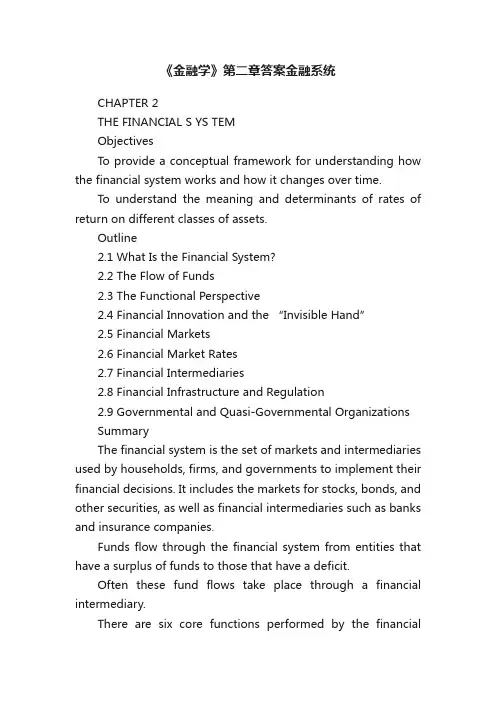
《金融学》第二章答案金融系统CHAPTER 2THE FINANCIAL S YS TEMObjectivesTo provide a conceptual framework for understanding how the financial system works and how it changes over time.To understand the meaning and determinants of rates of return on different classes of assets.Outline2.1 What Is the Financial System?2.2 The Flow of Funds2.3 The Functional Perspective2.4 Financial Innovation and the “Invisible Hand”2.5 Financial Markets2.6 Financial Market Rates2.7 Financial Intermediaries2.8 Financial Infrastructure and Regulation2.9 Governmental and Quasi-Governmental OrganizationsSummaryThe financial system is the set of markets and intermediaries used by households, firms, and governments to implement their financial decisions. It includes the markets for stocks, bonds, and other securities, as well as financial intermediaries such as banks and insurance companies.Funds flow through the financial system from entities that have a surplus of funds to those that have a deficit.Often these fund flows take place through a financial intermediary.There are six core functions performed by the financialsystem:1.To provide ways to transfer economic resources through time, across borders, and among industries.2.To provide ways of managing risk.3.To provide ways of clearing and settling payments to facilitate trade.4.To provide a mechanism for the pooling of resources and for the subdividing of shares in variousenterprises.5.To provide price information to help coordinate decentralized decision-making in various sectors of the economy.6.To provide ways of dealing with the incentive problems created when one party to a transaction hasinformation that the other party does not or when one party acts as agent for another.The fundamental economic force behind financial innovation is competition, which generally leads to improvements in the way financial functions are performed. The basic types of financial assets traded in markets are debt, equity, and derivatives.Debt instruments are issued by anyone who borrows money—firms, governments, and households.Equity is the claim of the owners of a firm. Equity securities issued by corporations are called common stocks.Derivatives are financial instruments such as options and futures contracts that derive their value from the prices of one or more other assets.An interest rate is a promised rate of return, and there are as many different interest rates as there are distinct kinds of borrowing and lending. Interest rates vary depending on the unitof account, the maturity, and the default risk of the credit instrument. The nominal interest rate is the promised amount of money you receive per unit you lend.The real rate of return is defined as the nominal interest rate you earn corrected for the change in the purchasing power of money. For example, if you earn a nominal interest rate of 8% per year and the rate of price inflation is also 8% per year, then the real rate of return is zero.There are four main factors that determine rates of return in a market economy:the productivity of capital goods—expected rates of return on mines, dams, roads, bridges, factories, machinery, and inventories,the degree of uncertainty regarding the productivity of capital goods,time preferences of people—the preference of people for consumption now versus consumption in the future, and risk aversion—the amount people are willing to give up in order to reduce their exposure to risk.Indexing is an investment strategy that seeks to match the returns of a specified stock market index.Financial intermediaries are firms whose primary business is to provide customers with financial products that cannot be obtained more efficiently by transacting directly in securities markets. A mong the main types of intermediaries are banks, investment companies, and insurance companies. Their products include checking accounts, loans, mortgages, mutual funds, and a wide range of insurance contracts.Solutions to Problems at End of Chapter1. Do you agree with Adam Smith’s view that society canrely more on the “invisible hand” than on government to promote economic pros perity?Student answers will vary of course.SAMPLE ANSWER:The communist system is the exact opposite of Adam Smith’s invisible hand. And of course we have recently seen the downfall of many of the communist countries around the world. In the communist world, it was believed that government could make better decisions promoting economic prosperity than individuals could. Clearly this system failed to promote economic prosperity. It seems that Adam Smith’s view was that competitive market systems as a whole (rather than government) could best allocate resources to promote economic prosperity. However, a completely unfettered capitalist society such as in the late 1800s in the Western world may n ot have been the perfect system either as the invisible hand helped the “rich get richer” while the poor and needy had no formal assistance. This outraged the moral fabric of society and government programs were eventually set up to formally address thisi ssue of general welfare and “fairness”.2. How does the financial system contribute to economic security and prosperity in a capitalist society?In a capitalist society, it is the price system which helps make capital resource decisions. Capital flows to those operations which can employ it to earn the highest rate of return. This therefore allocates capital to its most productive use, thereby enhancing society’s economic prosperity.In addition, the financial system has markets and intermediaries which transfer risks from those who are least willing to bear it to those who are most willing to bear it. This benefits society as a whole withoutcosting it anything. In addition, by allowing individuals to reduce or eliminate risks, it fosters an atmosphere of undertaking business ventures which also benefits society.3. Give an example of how each of the six functions of the financial system are performed more efficiently today than they were in the time of Adam Smith (1776).Clearing and settling payments:In Adam Smith’s day, just as today there was paper and coin currency. However, due to technological innovations (primarily the computer) today there are many additional forms of payment settlement such as personal checks, credit cards, debit cards and electronic transfer of funds. In addition, certain credit cards and traveler’s checks are accepted everywhere in the world making currency exchange a relic of the past. Pooling resources and subdividing shares:In Adam Smith’s day, most businesses were s mall and were financed by sole proprietorships. Therefore the need to pool resources to finance large investments was not as prevalent or as important as it is today. Again, the technological revolution of computers and telephones allow for global capital marke ts to efficiently finance today’s much larger businesses. Today these companies can access huge pools of money around the world and find the cheapest source of financing for large scale projects.Transfer economic resources: Today there is a worldwide financial system which facilitates the transfer of resources and risk from one individual to another and from one point in time to another. In Adam Smith’s day, although there were financial markets which played a limited role, they were localized, small and much less efficient and innovative than they are today.Managing risk: Of course during Adam Smith’s day individuals and businesses faced many of the same risks they dotoday (risk of property damage, risk of financial loss, risk of crop failure etc.) Ho wever, there were limited means to offset this risk. There were some insurance companies in place at that time, however, they concentrated on managing business risk rather than personal risk and certainly there was not the same type of insurance. A good ex ample is that in Adam Smith’s day, there was no unemployment insurance. In Adam Smith’s day, there was very little a farmer could do about reducing his risk of crop failure or lower crop prices. Today there are a vast number of markets and securities which can be used to offset individual and business risk as well as a huge network of insurance companies whose role is to transfer risk from those who want to reduce risk to those who want to take on more risk.Price information: During Adam Smith’s day, info rmation traveled slowly. Of course, there were no phones, televisions or radios. News traveled by newspaper and by the mail. Today, information travels around the worldinstantaneously. Due primarily to the growth and innovation in computer and telephone t echnology, information about security prices and performance is known at virtually the same time everywhere around the world.Incentive problems: As discussed above, today’s financial sy stem is large, innovative and global. In Adam Smith’s day, while there were problems of moral hazard and adverse selection (but less of a principal-agent problem) there was not the same financial system and sophistication to deal with these problems as there is today.4. How does a competitive stock market accomplish the result that Adam Smith describes? Should the stock market be regulated? How and why?Student answers will vary.SAMPLE ANSWER:Adam Smith talked about free and competitive markets as a system which allocates capital to its most productive use and greatest value. In a competitive stock market, prices are set through supply and demand. Those companies returning the highest return will be rewarded with the highest prices (or cheapest source of financing). Those companies which are under performing will not be allocated as much capital because they are not as productive. Because the universe of possible investments is huge and because it is at times difficult for investors to discern which companies are the most productive employers of capital, regulation shou ld be required to make sure relevant and standardized information is disseminated to potential investors. This would include regulation on disclosure and also insider trading and stock manipulation. However other forms of market regulation are perhaps not so important from a market efficiency point of view and may even impede society’s overall financial welfare.5. Would you be able to get a student loan without someone else offering to guarantee it?Since most students do not have any earning power (yet) or source of savings or other capital, it is doubtful any intermediary would take that credit risk at any reasonable interest rate.6. Give an example of a new business that would not be able to get financing if insurance against risk were not available.EXAMPLES:Chemical companyChild safety products companyAirlineBankHospitalEnvironmental consultingHazardous waste disposal7. Suppose you invest in a real-estate development deal. The total investment is $100,000. You invest $20,000 of your own money and borrow the other $80,000 from the bank. Who bears the risk of this venture and why?The $20,000 of my own money is considered the equity capital and the $80,000 is debt financing. In general it is the equity investors who absorb the primary risk of business failure. This is because if the business goes bankrupt, I will unlikely get any or my money back as the debt holders get paid back before I do. However, the debt holder also faces some risk that it will not even get back all its principal and interest. So lenders do share some of the business risk along with the equity investors.8. You are living in the United States and are thinking of traveling to Germany 6 months from now. You can purchase an option to buy marks now at a fixed rate of $0.75 per mark 6 months from now. How is the option like an insurance policy?An option means you have a choice. In this example you can choose to buy the marks at $0.75 in 6 months but you do not have to. You will only buy the marks at this price if it is cheaper for you to do so (if the spot market at that time is higher). Therefore, like an insurance policy you are protected against a potential loss. You know that the maximum price you will have to pay is $0.75 per mark and that you are protected against any higher price. Presumably you will have to pay something for the price of that option and that can be equated to an insurance premium.9. Give an example of how the problem of moral hazard might prevent you from getting financing for something you want to do. Can you think of a way of overcoming this problem?SAMPLE ANSWER:Suppose I want to start a biotechnology business and I need a lot of financing. The trouble is, I do not want to disclose my technology secrets to potential equity and debt investors. I will have great difficulty raising financing. But I could do the following: At a minimum, I could require all potential lenders and investors to sign agreements saying they will not disclose any of my secrets. Secondly, I could share some of my equity with potential lenders (equity-kickers) and investors (stock and stock options). At least that way they will not be motivated to disclose my secrets to others. Finally, if I decided I did not want to share secrets, I could give collateral in my new plant to the debt lenders and that might make them more comfortable with the issue of moral hazard.10. Give an example of how the problem of adverse selection might prevent you from getting financing for something you want to do. Can you think of a way of overcoming this problem?SAMPLE ANSWER:Suppose I want to start a car leasing business. Initially my plan was to purchase several automobiles and lease them out at attractive annual rates. However, potential lenders were worried that my business would attract individuals who drive great distances each year. Rather than buy their own car and lose significant value, they would lease my cars and take a new one each year. I would not be able to obtain financing for this business until I instituted annual mileage restrictions. This alteration in the business plan was enough to make the lenderscomfortable with the potential problem of adverse selection.11. Give an example of how the principal-agent problem might prevent you from getting financing for something you want to do. Can you think of a way of overcoming this problem?SAMPLE ANSWER:Suppose you want to start a personal care products company. However, you have the idea for the business, but you do not want to actually run the business. To do that you have hired an executive from a competitor. He will own no equity in the business but will be paid a salary of $100,000 to start up the business.Trouble with this example is that the executive you have hired has little incentive to make the business really work other than his salary (which presumably he could earn at many different companies). What if this executive is really a spy? It may be difficult to get financing for this venture. The way to solve the problem is if you the owner decide to run the business (you certainly are motivated for it do well) or at a minimum, grant your new employee stock or stock options in the business.12. Why is it that a country’s postage stamps are not as good a medium of exchange as its paper currency? Postage stamps would be much easier to copy (to counterfeit) than paper currency which has intricate designs and is made of special fibers (not easily duplicated). Secondly, postage stamps would not be as durable as paper currency and because of their other use, could easily stick to other items! Finally, because postage stamps are used for another purpose, one might run out of them and have to make a special trip to the post office to get more. Of course, the post office is not as convenient as an ATM machine for getting a new supply of currency.13. Who is hurt if I issue counterfeit U.S. dollars and use them to purchase valuable goods and services?If this were done in great size, everyone would be hurt through the inflation that would result in the increased money supply. However, if done in a s mall amount, the individuals accepting the currency are taking on the risk (without knowing it) that the dollars will not be accepted by others as a medium of exchange.14. Some say the only criterion to use in predicting what will serve as money in the future is the real resource cost of producing it, including the transaction costs of verifying its authenticity. According to this criterion what do you think will be the money of the future?SAMPLE ANSWER:Payments via electronic transfer may become the medium of choice. It is a very cheap way to create currency. The biggest challenge will be to create security systems that do not allow for tampering and fraud. Once this is done and once most individuals and retail establishments have access to the system (through bank accounts and linking computer systems) then this should become the “currency” of choice.15. Should all governments issue debt that is indexed to their domestic price level? Is there a moral hazard problem that citizens face with regard to their public officials when government debt is fixed in units of the domestic currency?The answer is that all governments should issue debt that is indexed to their domestic price level. This is due to the fact that if debts are not indexed to the domestic price level, governments have the incentive to print money to repay those debts, thereby increasing domestic inflation which negatively impacts all ofsociety.16. Describe your country’s sy stem for financing higher education. Wh at are the roles played by households, voluntary non-profit organizations, businesses and government?SAMPLE ANSWER:In the United States, the vast majority of higher education is paid for by individuals through savings. These sums can be supplemented in whole or in part by government-guaranteed loans and through student loans and scholarships provided by universities themselves as well as by private foundations such as those provided by the Fulbright scholarship.17. Describe your country’s system for fin ancing residential housing. What are the roles played by households, businesses and government?SAMPLE ANSWER:In the United States individuals and individual borrowings from savings and loans, commercial banks and mortgage lending companies finance the vast majority of residential housing through individual equity savings. The government guarantees a certain amount of low income mortgages and local governments finance some low-income housing. Businesses play a role through the lending business as well as through the financial markets which provide liquidity for portfolios of certain standardized mortgages.18. Describe your country’s system for financing new enterprises. What are the roles played by households, businesses and government?SAMPLE ANSWER:In the United States, the vast majority of new enterprises is financed through individual savings and through initial publicofferings made to the general public. These sources of financing are augmented by established firms which spend research and development (R&D) dollars developing new products and businesses and by venture capital institutions which also provide start-up financing.19. Describe your country’s system for financing medical research. What are the roles played by voluntary non-profit organizations, businesses and government?SAMPLE ANSWER:In the United States, medical research is financed both by non-profit organizations (such as universities and medical facilities as well as organizations such as the American Heart Association) as well as by businesses such as Merck, Johnson & Johnson and Genentech. The government is involved in research grants, primarily to universities.20. Assume there are only two stocks traded in the stock market, and you are trying to construct an index to show what has happened to stock prices. Let us say that in the base year the prices were $20 per share for stock 1 with 100 million shares outstanding and $10 for stock 2 with 50 million shares outstanding. A year later, the prices are $30 per share for stock 1 and $2 per share for stock 2. Using the two different methods explained in the chapter, compute stock indexes showing what has happened to the overall stock market. Which of the two methods do you prefer and why? (See appendix that follows.) DJI-Type Index = Average of Current Prices/Average of Base Prices * 100 = 106.67S&P-Type Index = (Weight of Stock 1 * Current Price of Stock 1 / Base Price of Stock 1 + Weight of Stock 2 * Current Price of Stock 2/Base Price of Stock 2) * 100 = 124The S&P-Type Index accurately reflects what has happened to the total market value of all stocks.。
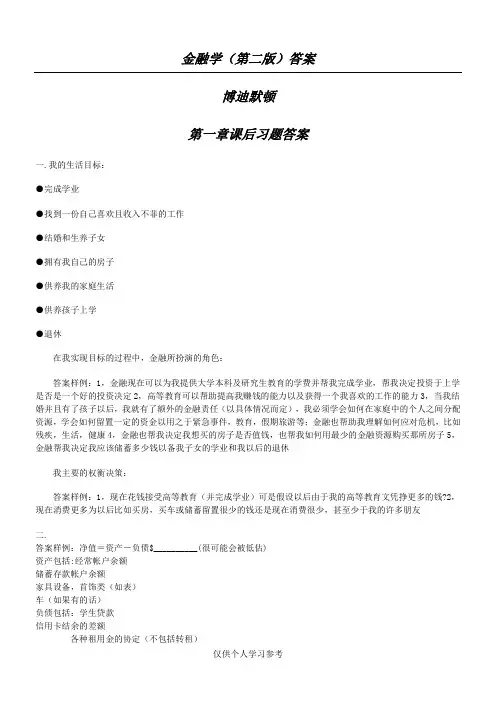
金融学(第二版)答案博迪默顿第一章课后习题答案一.我的生活目标:●完成学业●退休3,当我结5,?2,现在消费更多为以后比如买房,买车或储蓄留置很少的钱还是现在消费很少,甚至少于我的许多朋友二.答案样例:净值=资产-负债$__________(很可能会被低估)资产包括:经常帐户余额储蓄存款帐户余额家具设备,首饰类(如表)车(如果有的话)负债包括:学生贷款信用卡结余的差额各种租用金的协定(不包括转租)应付车款在计算净值时学生会特别地排除了他们一生潜在的赚钱能力的价值三.一个单身汉之需要养活他自己,所以他可以独立自主的作出金融决策。
如果他不想购买健康保险(而愿意承担由这个决定而带来的金融风险)那么除了这个单身汉自身,没谁会受这个决定的影响。
另外,他不需要在家庭成员之间分配收入这件事上做任何决定。
单身汉是很灵活自由的,可以选择住在几乎任何地方。
他主要是在今天的消费(开支)和为明天储蓄之间做出权衡决策。
既然他只需要养活他自己,那么他储蓄的重要性就比对一家之主的重要性小。
有许多孩子的一家之长必须在这些家庭成员中分配资源[或者说是收入].他们必须随时准备着处理各种风险,比如说潜在财政危机的突然发生[诸如家庭成员经历的严重健康问题,或者因为火灾和其他疏忽导致的保险问题].因为在一般一个家庭里人会比较多,有些人生病或受伤的风险就会更大.并且因为家庭中有许多依赖性的个体,所以薪水收入者得认真地考虑生活和残疾保险.还有,家庭并不像个体那样富有机动性,这是因为有了适龄儿童的缘b.1银行借贷2汽车经销商借贷或租赁3个人储蓄C(略)d你应该从可选择的融资方式中选择成本最小的一种。
当你分析的时候,你应该考虑以下方面:1你是否有足够的现金储蓄去购买?为了买车,你必须放弃的利息?你付现金和贷款所付是否不同?2对于不同的贷款方式,首付金额是多少?月付多少?付多久?相关利息是多少?整个贷款是按月还清,还是期末一次还清?税收和保险费是否包括在月付款中?3对于不同的租赁方式,首付金额是多少?月付多少?付多久?在租赁期末你是否拥有车?如果不拥有,买车要花多少?在租赁期末你是否必须得买车?你是否拥有优先购买权?如果你不买车你是否得付钱?相关利息是多少?税收和保险费是否包括在月付款中?是否有里程限制?七.a为学生们提供个人服务可能是个低成本的选择。
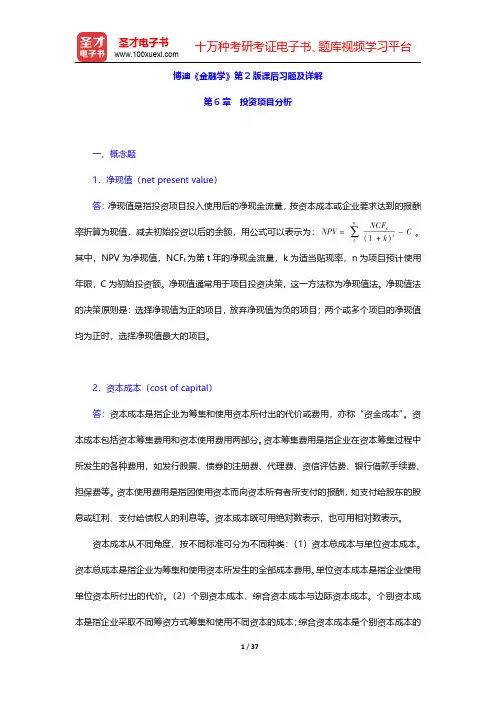
博迪《金融学》第2版课后习题及详解第6章投资项目分析一、概念题1.净现值(net present value)答:净现值是指投资项目投入使用后的净现金流量,按资本成本或企业要求达到的报酬率折算为现值,减去初始投资以后的余额,用公式可以表示为:。
其中,NPV为净现值,NCF t为第t年的净现金流量,k为适当贴现率,n为项目预计使用年限,C为初始投资额。
净现值通常用于项目投资决策,这一方法称为净现值法。
净现值法的决策原则是:选择净现值为正的项目,放弃净现值为负的项目;两个或多个项目的净现值均为正时,选择净现值最大的项目。
2.资本成本(cost of capital)答:资本成本是指企业为筹集和使用资本所付出的代价或费用,亦称“资金成本”。
资本成本包括资本筹集费用和资本使用费用两部分。
资本筹集费用是指企业在资本筹集过程中所发生的各种费用,如发行股票、债券的注册费、代理费、资信评估费、银行借款手续费、担保费等。
资本使用费用是指因使用资本而向资本所有者所支付的报酬,如支付给股东的股息或红利、支付给债权人的利息等。
资本成本既可用绝对数表示,也可用相对数表示。
资本成本从不同角度、按不同标准可分为不同种类:(1)资本总成本与单位资本成本。
资本总成本是指企业为筹集和使用资本所发生的全部成本费用。
单位资本成本是指企业使用单位资本所付出的代价。
(2)个别资本成本、综合资本成本与边际资本成本。
个别资本成本是指企业采取不同筹资方式筹集和使用不同资本的成本;综合资本成本是个别资本成本的加权平均数,反映企业筹集和使用资本的综合成本水平;边际资本成本是指资本每增加一个单位而增加的成本。
个别资本成本反映某种筹资方式的资本成本水平,综合资本成本反映企业各种筹资方式的综合资本成本水平,边际资本成本则反映追加资本的资本成本水平。
(3)负债资本成本与权益资本成本。
3.敏感性分析(sensitivity analysis)答:敏感性分析是指在确定性分析的基础上,通过进一步分析,预测项目主要不确定因素的变化对项目评价指标(如会计内部收益率、净现值等)的影响,从中找出敏感因素,确定评价指标对该因素的敏感程度和项目对其变化的承受能力的分析方法。
金融学课后习题答案第二版【篇一:王重润公司金融学第二版课后答案】业有几种组织方式?各有什么特点?( 1)有两种,有限责任公司和股份有限责任公司( 2)有限责任公司特点:有限责任公司是指股东以其出资额为限对公司承担责任,公司以其全部资产对公司的债务承担责任的企业法人;有限责任公司注册资本的最低限额为人民币3万元;其资本并不必分为等额股份,也不公开发行股票,股东持有的公司股票可以再公司内部股东之间自由转让,若向公司以外的人转让,须经过公司股东的同意;公司设立手续简便,而且公司无须向社会公开公司财务状况。
( 3)股份有限责任公司特点:1、有限责任2、永续存在3、股份有限责任公司的股东人数不得少于法律规定的数目,我国规定设立股份有限公司,应当有2人以上200人以下为发起人4、股份有限责任公司的全部资本划分为等额的股份,通过向社会公开发行的办法筹集资金,任何人在缴纳了股款之后,都可以成为公司股东,没有资格限制。
5、可转让性6、易于筹资2题:为什么我国《公司法》允许存在一人有限责任公司?一人有限责任公司与个人独资企业有何不同?答:1.就立法初衷而言,许可自然人投资设立一人有限责任公司的重要考虑是减少实质上的一人公司的设立,简化和明晰股权归属,减少纷争。
以往由于我国《公司法》禁止设立一人公司,使得投资人通过各种途径设立或形成的实质上的一人公司大量存在,挂名股东与真实股东之间的投资权益纠纷以及挂名股东与公司债权人之间的债务纠纷不断,令工商行政管理部门和司法机关无所适从。
在修订《公司法》的过程中,法律委员会、法制工作委员会会同国务院法制办、工商总局、国资委、人民银行和最高人民法院反复研究认为:从实际情况看,一个股东的出资额占公司资本的绝大多数而其他股东只占象征性的极少数,或者一个股东拉上自己的亲朋好友作挂名股东的有限责任公司,即实质上的一人公司,已是客观存在,也很难禁止。
根据我国的实际情况,并研究借鉴国外的通行做法,应当允许一个自然人投资设立有限责任公司。
第一章货币与货币制度答案二、单项选择1(B);2(A);3(B);4(D);5(B);6(A);7(D);8(D);9(D);10(D);11(B);12(A);13(A);14(C);15(B);16(C);17(B);18(A);19(C);20(B);三、多项选择1(B、C、D);2(A、B);3(A、C、D);4(A、B、C);5(A、D);6(C、D);7(B、D);8(B、C);9(A、B、D);10(A、C、D)。
四、判断并改错1.(×)将“平行本位制”改为“双本位制”。
2.(×)将“铸币”改为“商品货币”。
3.(×)将“支付手段”改为“价值尺度”。
4.(×)将“银币”改为“劣币”;将“金币”改为“良币”。
5.(×)将“流量”改为“存量”。
6.(×)将“无限”改为“有限”。
7.(×)将“相互尊重”改为“需求的双重巧合”。
8.(×)将“必须”改为“不必”。
9.(×)将“支付手段”改为“交易媒介或流通手段”。
10.(×)将“一定”改为“不需要”。
11.(×)将“收益性”改为“流动性”。
12.(×)将“价值尺度”改为“交易媒介或流通手段”。
13.(×)将“越大”必为“越小”;或者将“越强”改为“越弱”。
14.(×)将“不是”改为“也是”。
15.(×)删除“和支票”。
16.(×)将“储藏手段”改为“交易媒介或流通手段”。
17.(×)将:“金汇兑本位制”改为“金块本位制”。
18.(×)将“金币本位制”改为“金块本位制”。
19.(×)将“M3”改为“M2”。
20.(×)将“金块本位制”改为“金汇兑本位制”。
五、填空题1.(流动性);2.(贵金属货币);3.(代用货币);4.(信用货币);5.(电子货币);6.(流通手段或交易媒介);7.(观念上);8.(币材或货币材料);9.(双本位制);10.(跛行本位制);第二章信用与信用工具答案二、单项选择1(D);2(D);3(B);4(B);5(B);6(B);7(C);8(A);9(A);10(C);11(A);12(C);13(A);14(B);15(B);16(A);17(C);18(C);19(D);20(C);三、多项选择1(A、B);2(A、B、C、D、E);3(A、B);4(A、B、C);5(A、B、C、D);6(A、B、D);7(A、D);8(B、C);9(A、B、D);10(A、B、C)。
1•价值2•时间3•复利4•贴现率5•普通年金6•终值1.ABCD2.ABE3.A4.B5.A6.A7.C8.C 1•什么是货币的时间价值,怎样计算货币的时间价值?货币资金的时间价值是指货币经历一定时间的投资和再投资所增加的价值。
货币时间价值有两种表示方法:(1)绝对数,即增值额(△G): (2)相对数,即增值额(△G)和本金(P)的比率,它是相当于在没有风险和通货膨胀条件下的社会平均资金利润率。
计算利息有两种方法,单利法和复利法单利是指在计算利息时,不论期限长短,仅对本金计算利息,本金所生利息不再加入本金计算下期利息。
单利计算公式为:I=P • r•nS=P(l+r • n)式中,I表示利息额,P表示本金,r表示利息率,n表示借贷期限,S表示本金和利息Z 和,简称本息和。
复利是指计算利息时,不仅对本金计息,而且对本金在上一时期所生利息加入木金一并计算利息,逐期滚算。
其计算公式为:S=P - (1+r)*I=S - P在复利计息方式下,在到期R之前每一年所生的利息将被进行再投资并获得利息,即利滚利。
由于复利计息有利于加强资金的时间观念,而且便于比较不同期限的资金使用效益,更符合资金的时间价值概念a2.如何理解终值和现值?利率的变动对现值和终值有什么影响?终值是指现在的一定资金按复利计息方法计算在将来某一时期结束后获得的本金和利息之和,用FV表示。
如果我们用PV表示初始的资金,用r表示利率, 用n表示计息的期数,则FV二PV(l+r)%现值是在复利计息方式下,未來一定金额按照某一利率折算到现在的价值,或者说为取得将来一定的本利和,现在需要付出的本金。
通过复利的终值计算公式FV=PVX(l+r)^我们可以倒推出现值的计算公式:由公式可知,终值同利率同方向变动,现值同利率反方向变动。
3.年度百分率和有效年利率之间的关系是怎样的?年度百分比率(annual percent age rate, APR )是指银行等金融机构提供 的利率,也叫做报价利率。
2、你现在有10000元资金准备存在银行 5年,有3种存款方式可选择:存1年期存款, 每年到期后连本代利转存 4次;存3年期存款,到期后连本代利转存 1年期存款2次;存5 年期存款1期。
1年期、3年期5年期存款的年利率分别为 2%、2.2%和3%。
请问3种方 式5年后的终值各为多少?哪种方案最优?解:Fy =10000 (1 2%)5 =11040.81FV 2 =10000 (1 2.2% 3) (1 2%)2 =11090.66 FV 3 = 10000 (1 3% 5) =11500因此,方案3最优3. 你现在每个月存款 1000元,年利率为3%,10年后你有多少钱?这 10年存款的现 值为多少钱?4. 你准备购买价值 40万元的住房一套,目前 1年期存款利率为5%,贷款利率为6%, 利息收入税为20%,预测未来5年房地产价格平均每年上涨 3%。
你有3种方案可供选择, 以A 方案所需的时间计算,各方案的净现值和内涵报酬率为多少?哪种方案最优?A .你每个月存款5000元,多长时间你可以存储到可以一次性全额付款方式(一次性付清房款打九八折)购买该类住房所需的资金?B • 你现在贷款购买该住房,每月还款5000元,多长时间能够还清贷款?C • 如果你将贷款购买的住房出租,每月房租为1500元,一并用于归还贷款,多长时间能够还清贷款?解: FV 120八 1000 (1t =1 3%)t =139741.42 (元) 12PV 119=亠 1000t £)t=103561.75 (元)5解:方案A :粗略估计0.98 400000 (1 3%) /60000 5年,所以在第六年起房价不上涨的假设下,付款的终值为0.98 400000 (1 • 3%)5 = 454435.44 (元) 一年期存款实际利率为0.8 5% =4%,设从现在起第n月底可以一次性全额付款,则终值满足下列方程5 0.98 400000 (1 3%)5二「5000 (V 4%)nl t A12得到n =80,也即第7年8月底可以一次性全额付款。
《金融学》习题二+答案
2
———————————————————————————————— 作者: ———————————————————————————————— 日期:
3
《金融学》习题二 (第5章—第8章) 一、判断并改错 1.当市场利率上升时,证券行市也上升(下降)。(F )利率下降时,股票的价格就上涨;利率上升时,股
票的价格就会下跌。 2.在金融资产中可直接作为货币的金融资产,一般来说,其内在价值就是票面标注的金额。(T ) 3.远期合约和期货合约的区别主要在于期货合约是一个标准化的合约。(T ) 4.金融体系是指一国一定时期金融机构的总和。( T ) 5.在我国,经纪类证券公司可从事证券承销、经纪、自营业务。(F )经纪类证券公司在我国是指只能
从事单一的经纪业务的证券公司. 证券公司必须将其证券经纪业务、证券承销业务、证券自营业务和证券资产管理业务分开办理,不得混合操作. 经纪类证券公司只允许专门从事证券经纪业务. 6.投资银行的主要资金来源是吸收存款。( T ) 7.我国的财务公司是由大经济集团组建并主要从事股票和债券的发行。(集团内部融资)(F ) 8.我国1994年成立了国家开发银行、中国进出口银行和中国农业银行(中国农业发展银行)三家政策性银行。(F ) 9.通知放款是商业银行之的(证券人与商业银行的)短期资金拆借。( F ) 10.商业银行的最基本职能是充当企业之间的支付中介(信用中介)。(F ) 11.我国在1995年颁布的《中华人民共和国商业银行法》中确立了混业经营(分业经营)的原则。(F )1995年颁布的《中华人民共和国商业银行法》中确立了商业银行与其他金融业务分业经营的原则。
12.商业银行的全部资金来源就是吸收外来的资金。(F)商业银行的资金来源包括自有资金和外来资金两
部分,其中包括:1、吸收存款(主要资金来源渠道) 2、向中央银行借款3、结算过程中占用短期资金 4、发行股票5、同业拆借 13.信用证、信用卡和证券投资都是商业银行的表外业务。(F)信用卡是中间业务,证券投资是表内业务
14.商业银行的表外业务就是(不完全是)中间业务。(F)国外商业银行通常将中间业务统称为表外业务。
广义的表外业务是指所有的中间业务,狭义的表外业务是指构成银行或有负债的风险较高的表外业务。中国商业银行一般将广义的表外业务称为中间业务。但通常我们所说的表外业务主要指的是狭义的。 15..中央银行独占货币发行权是中央银行区别于商业银行的根本标志。(T ) 16.最早全面发挥中央银行功能的是瑞典银行(英格兰银行)。(F ) 17.目前,我国政府财政出现赤字时,可以向中国人民银行进行透支。(F )1995年《人民银行法》第
二十八条规定“中国人民银行不得对政府财政透支,不得直接认购、包销国债和其他政府债券” 18.中央银行与政府所处的地位、行为目标不尽相同。因此,中央银行应对政府保持绝对的(相对的)独立性。( F ) 19.通常全额实时清算采用的是大额资金转账系统,而净额批量清算采用小额定时结算系统。( T ) 二、填空题 1、货币市场主要包括票据贴现市场、国库券市场、回购市场、银行间拆借市场、可转让大额存单市场。 2、发行人公开向投资人推销证券的证券发行方式称为公募发行。 3、投资人按照当前市场价格购买债券并且一直持有到期满时可以获得的年平均收益率称为到期收益率。
4、交易期限在1年以内的短期金融交易市场称为货币市场。 5、资本市场主要分为长期借贷市场、长期证券市场。 6、衍生金融产品主要有远期、期货、期权和互换。 7、交易期限在1年以上的长期金融交易市场称为资本市场。 8、组织证券发行的市场称为证券市场。
4
9、根据有效市场假说,证券市场按照交易效率可分为弱有效市场、中度有效市场、强有效市场。 10、金融市场按照金融产品期限可以划分为资本市场和货币市场。 11、对已经发行的证券进行交易的市场称为证券交易市场。 12、投资基金按照法律地位分为契约型基金和公司型基金。 13、金融市场按金融交易的交割期限可分为远期市场和期货市场。 14、发行人直接对特定的投资人销售证券的证券发行方式称为私募发行。 15、上市条件比主板低,专门针对小型企业以及创业企业的股票交易市场称为创业板市场。 16、由政府设立,以贯彻国家产业政策、区域发展政策等为目标的金融机构称为政策性银行。 17、商业银行按经营模式划分可分为分工型银行和全能型银行。 18、商业银行的负债业务主要包括吸收存款、银行同业拆借、发行金融债券、从中央银行借款、从国际货币市场借款、结算过程中的短期资金占用等。 19、商业银行的资产业务主要有贴现、贷款、证券投资等。 20、商业银行的经营三原则为盈利性、流动性和安全性。 21、中央银行的基本职能主要有发行的银行、银行的银行、国家的银行。 22、中央银行作为银行的银行,其职能主要表现为集中存款准备、最后贷款人、组织全国清算。 三、选择题 ( D )l.融资期限在一年以上的金融市场的是: A.货币市场 B.发行市场 C.流通市场 D.资本市场 ( A )2.若定期存款利率(单利)3年期为年7.92%,5年期为年8.28%,那么8年期应为年: A.9.00% B.9.40% C.16.2% D.9.22% ( C )3. 金融市场的交易价格一般是指: A. 交易费用 B. 手续费 C. 利率 D. 佣金 ( D )4.下列属于间接融资的是: A.商业信用 B.股票的发行 C.债券的发行 D.通过金融机构的融资 ( AE )5.间接融资领域中的金融中介有: A. 商业银行 B. 投资银行 C. 证券公司 D. 证券经纪人 E.保险公司 ( A )6.在银行体系中,处于核心地位的是: A.中央银行 B.专业银行 C.商业银行 D.投资银行 ( D )7.商业银行以什么为主要的资金来源? A.资本金 B.发行金融债券 C.向中央银行借款 D.存款负债 ( AE )8. 商业银行的中间业务包括: A.承兑业务 B.信托业务 C.代理业务 D.存款业务 E. 汇兑业务 ( ADE )9.商业银行的负债业务包括: A.存款负债 B.票据贴现 C.票据承兑 D.中央银行借款 E.发行金融债券 ( AB )10.商业银行的资产业务主要有: A.贷款业务 B.投资业务 C.信托业务 D.结算业务 E.发行金融债券 ( ABD )11. 以下属于商业银行资金来源的有: A. 存款 B. 同业拆借 C. 贷款 D. 再贴现 E. 证券投资 ( A )12.流动性最高而收益性最低的是: A.现金资产 B.贷款 C.短期资产 D.短期投资 ( C )13. 不属于商业银行主动负债的是: A.银行同业拆借 B. 吸收存款 C. 回购协议 D. 向央行贴现 ( C )14. 商业银行与其他金融机构区别之一在于其能接受: A. 原始存款 B. 定期存款 C. 活期存款 D. 储蓄存款
5
( A )15.商业银行的性质是: A. 企业 B. 国家机关 C. 具有国家机关和企业的双重性 D. 政府部门 ( D )16. 流动性强弱的依次划分是: A. 定期存款、储蓄存款+M1 B. M2+活期存款、现金 C. 现金、活期存款+M2 D. 现金、活期存款、定期存款、储蓄存款、债券 ( AD)17. 中央银行的存款主要是: A. 财政存款 B. 企业存款 C. 储蓄存款 D. 金融机构的准备金存款 E.居民存款 ( B )18.中央银行是: A.企业 B.具有国家机关性质的特殊中央金融机构 C.特殊企业 D.具有国家机关和企业双重属性的金融机构 ( ABC )19. 中央银行的性质包括: A. 机构数量最多,业务量最大 B. 是金融机构的领导和核心 C. 是唯一发行货币的银行 D. 是银行的银行 E. 是政府(国家)的银行 ( B )20. 下列中央银行的资产业务中,使商业银行体系准备金减少的业务是: A. 央行增加对存款机构的贷款 B. 央行出售政府证券 C. 央行向其他国家中央银行购买外国通货 D. 央行代表财政部购买黄金 ( A )21. 中央银行最重要的负债业务是: A.货币发行 B.代理国库业务 C.集中存款准备金 D.国际金融机构负债 ( C )22. 以下属于中央银行的业务对象的是: A.企业 B. 居民 C. 政府 D. 团体组织 ( A )23. 在中央银行三大职能中,集中保管商业银行的存款准备金是中央银行什么职能的具体表现? A. 银行的银行 B.政府的银行 C. 发行的银行 D.最后贷款人 四、简答题 1.简述同业拆借市场的特点与参与者。 同业拆借市场具有以下特点: (1) 市场准入方面一般有严格的限制。 (2) 同业拆借融通资金的期限较短,流动性高。 (3) 交易手段先进,交易手续简便。 (4) 拆解的金额较大,交易具有无担保性。 (5) 同业拆借市场的利率由双方协定,随行就市,变动频繁。 同业拆借市场参与者: (1) 资金需求者:主体为商业银行 (2) 资金供给者:有超额储备的金融机构,包括商业银行、非银行金融机构、境外代理行及境外银行在境内的分支机构,有时也包括外国的中央银行。 (3) 交易中介机构:专营(专门的中介机构)、兼营(多为商业银行) (4) 交易中心 (5) 中央银行与金融监管机构 2.简述商业银行经营的三条原则,并说明这三者之间的关系。 商业银行的经营有三大原则:盈利性、流动性、安全性。 三大原则既有统一的一面,又有矛盾的一面。总体来说,安全性与流动性是正相关;流动性强的资产,风险性小,安全有保障。但它们与盈利性往往有矛盾:流动性强,安全性好,盈往往流动性差,风险性高。